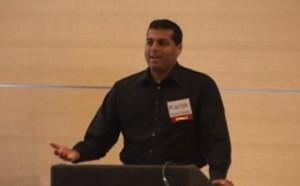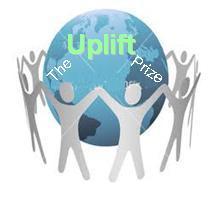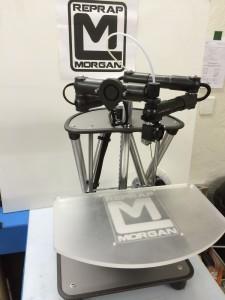
Kartik Gada at the Foresight 2010 Conference
If you’ve donated money to a charity, you may have wondered where, exactly, the money goes. How much of it is going directly to the aid of the people in need as opposed to overhead costs? Worse, investigative reporting has exposed a disturbing amount of corruption within several charities; there’s an unpleasant but real possibility that not a cent of our donations ever reaches the starving people we see on the brochures. Kartik Gada found himself asking these questions, as well as the question of why, even with the most reputable charities plus foreign government aid funneling billions of dollars into poverty reduction, poverty is still so rampant. He came to the conclusion that the current system of charity is deeply flawed, and perpetuates a vicious cycle of dependency.
“The entire process is premised on the assumption of a zero-sum redistribution, with no concept of incentives or self-sufficiency at all,” he said. “From my experiences in India, I have seen that even the most destitute person, once they receive enough food for the next week, very quickly defaults into a mentality of not needing to take any further action for the remainder of the week. Needless to say, the traditional model of charity is broken, and is no longer helping the intended recipients, who have been trained to anticipate handouts.”
So he got to work on creating a new model, one based on the principle “Give a man a fish and you feed him for a day; teach a man to fish and you feed him for a lifetime.” Technological advances in the developed world have changed the lives of billions; un fortunately, people living in abject poverty have little or no access to technology. He decided that the solution would be to find a way to put technology – namely, 3D printing – into the hands of the poorest. With a 3D printer and the necessary raw materials, a destitute person suddenly has a tool for producing commodity goods and carving out his own manufacturing sector, making a dent in the current cheap-labor, mass-manufacturing trend that keeps so many in poverty.
fortunately, people living in abject poverty have little or no access to technology. He decided that the solution would be to find a way to put technology – namely, 3D printing – into the hands of the poorest. With a 3D printer and the necessary raw materials, a destitute person suddenly has a tool for producing commodity goods and carving out his own manufacturing sector, making a dent in the current cheap-labor, mass-manufacturing trend that keeps so many in poverty.
Sounds like a great idea, you may be thinking. But where is the money for millions of 3D printers going to come from? Gada had the perfect solution: the RepRap project. Since 2004, inventors have been working on perfecting self-replicating 3D printers. For many of them, it’s a hobby. For Gada, it was the key.
“I believe that this sort of technology could cause a massive paradigm shift in how low-cost manufacturing is done,” he said. “A machine that could print just about any basic solid object of daily utility, and even print electrical circuits, is useful enough. If the same machine can also print 90% of the parts needed to build a copy of itself, then mass-distribution of this ‘personal manufacturing’ machine would be extremely easy.”
Thus, in 2009, the Uplift Prize was born. Gada issued a challenge to the RepRap community: whoever can build the best self-replicating printer by a certain date wins a monetary prize. He outlined several of the issues facing current self-replicating printer models, and made fixing those problems the criteria. Two deadlines were presented. First was an Interim Prize of $20,000 to the individual or team who built the best printer with the following characteristics: low one-off materials and parts cost; low power requirements; a minimum of specialist parts and a maximum of parts it could print for itself; and a requirement of very little skill and experience from the person operating it. It also needed to be totally o pen-source. On June 30, 2013, that prize was awarded to Quentin Harley for his printer, “Morgan.”
pen-source. On June 30, 2013, that prize was awarded to Quentin Harley for his printer, “Morgan.”
The second prize, the Grand Personal Manufacturing Prize, upped the ante. With an $80,000 prize at stake, inventors were to further improve on the printer in any number of ways. Increasing its speed and productivity was key, and Gada also suggested making it more eco-friendly by using recycled material. A long list of suggestions was presented, and, in December of 2015, the Grand Personal Manufacturing prize will be awarded to the inventor or team who most closely meets or exceeds the criteria. (A separate contest was also launched, it should be noted, for the creation of a device that would enable individuals to filter their own water for under $1.25. The Water Liberation Prize will also be awarded in December.)
The judges include RepRap project founder Dr. Adrian Bowyer, Dr. Forrest Higgs, and Gada himself. The prize is where you come in. To raise the $80,000, Gada has launched an Indiegogo campaign. A donation as little as $1.00 is tax-deductible, and $100 will get your name on the Uplift Prize web page and in the RepRap wiki. Donate $10,000 and you can participate in judging. Donate any amount, and you’re helping to lift billions out of poverty, as well as taking a front seat to watch how 3D printing can potentially change global economic infrastructure.
“Self-replicating 3D Printing, as it gets beyond 90% of the parts printable, introduces a radical overhaul in the economics of manufacturing,” Gada told 3DPrint.com. “The Uplift Prize drives down the cost of self-replicating 3D Printing, getting ever-closer to true self-replication.”
One more thing: because of the Uplift Prize’s zero overhead, you can rest assured that every penny of your donation will go exactly where you intend it to go.
Garda will be speaking at MecklerMedia’s Inside 3D Printing conference in Santa Clara on October 21st, 4:15-5:00 pm, in the New Ideas in 3D Printing panel, alongside other “entrepreneurs and visionaries who are leading the charge into the future of additive manufacturing.” The panel includes Gada, Tyler Benster (3D Printing Evangelist), Michael Petch (Founder, Black Dog Consulting; Author, 3D Printing: Rise of the Third Industrial Revolution), Stephan Thomas (Co-Founder, Identify3d), and Will Van Epern (Vice President, Wild Blue Technologies and Avatarium 3D). Remember that 3DPrint.com readers can save 10% on registration by using discount code 3DPRINT.
Let us know your thoughts on this prize in the Uplift Prize Forum thread on 3DPB.com. Below is a video introducing the Uplift Prize from the Indiegogo campaign:
Subscribe to Our Email Newsletter
Stay up-to-date on all the latest news from the 3D printing industry and receive information and offers from third party vendors.
You May Also Like
Gorilla Sports GE’s First 3D Printed Titanium Cast
How do you help a gorilla with a broken arm? Sounds like the start of a bad joke a zookeeper might tell, but it’s an actual dilemma recently faced by...
Nylon 3D Printed Parts Made More Functional with Coatings & Colors
Parts 3D printed from polyamide (PA, Nylon) 12 using powder bed fusion (PBF) are a mainstay in the additive manufacturing (AM) industry. While post-finishing processes have improved the porosity of...
$25M to Back Sintavia’s Largest Expansion of Metal 3D Printing Capacity Since 2019
Sintavia, the digital manufacturing company specializing in mission-critical parts for strategic sectors, announced a $25 million investment to increase its production capacity, the largest expansion to its operations since 2019....
Velo3D Initiates Public Offering in a Bid to Strengthen Financial Foundations and Drive Future Growth
Velo3D (NYSE: VLD) has been among a number of publicly traded 3D printing firms that have attempted to weather the current macroeconomic climate. After posting a challenging financial report for 2023,...
































